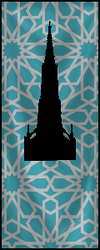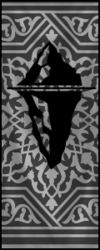More actions
No edit summary |
No edit summary |
||
| Line 45: | Line 45: | ||
==Design== | ==Design== | ||
===Physical Characteristics=== | ===Physical Characteristics=== | ||
Isldar are similar to [[Teledden]] (the High Elves). Like all [[Nelfin]], they are more slender and tall than Humans. Isldar specifically have pale skin and long, pointy ears, longer than those of other Nelfin Races. Death and Life Isldar can have natural black or white hair, though many dye it other colors. The only real way to tell Death and Life Isldar apart is that Life Isldar have purple irises with blue specks in them, while Death Isldar have green irises with blue specks in them. Both kinds may also have blue, green, or black sclera. | Isldar are similar to [[Teledden]] (the High Elves). Like all [[Nelfin]], they are more slender and tall than Humans. Isldar specifically have pale skin and long, pointy ears, longer than those of other Nelfin Races. Death and Life Isldar can have natural black or white hair, though many dye it other colors. The only real way to tell Death and Life Isldar apart is that Life Isldar have purple irises with blue specks in them, while Death Isldar have green irises with blue specks in them. Both kinds may also have blue, green, or black sclera. Isldar are ageless: they look young forever, even into old age, but can choose to look older inside of adult age ranges. | ||
==Summary of Racial Abilities== | ==Summary of Racial Abilities== | ||
Revision as of 23:51, 21 March 2023
| Isldar | |
|---|---|
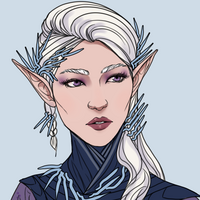 | |
| Race | |
| Pronunciation | Ysel-dar |
| Classification | Nelfin |
| Subraces | None |
| Common Nicknames |
|
| Languages | Sulvaley |
| Naming Customs | Fantasy Elven (but not Tolkien Elven) |
| Racial Traits | |
| Distinctions | Snow Elves who guard the cycle of life and death and the memory of Dragons |
| Maximum Age | 500 years |
| Height | Tall |
| Eye Colors | Any shade of purple if Life Isldar, any shade of green if Death Isldar |
| Hair Colors | Black or White, regardless of which cult they belong to |
| Skin Tones | |
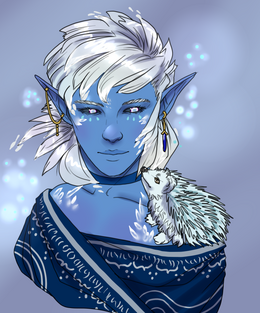
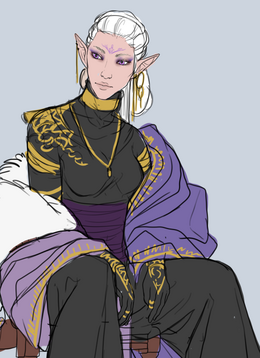
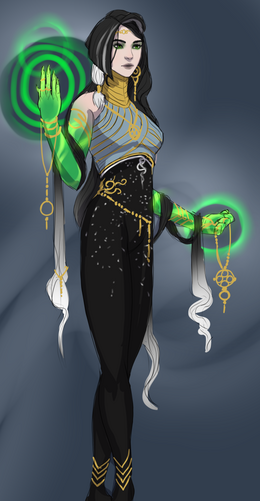
Mysterious, seclusive, and individualist: this and more sets the Isldar apart, guardians of the icy wastes of Ellador, and shepherds of the lost souls left behind by millennia of tragedy. The Isldar originated from the Dregodar in the Allorn Empire, a cult of Dragon Worshipers who fled their homeland under persecution. Hard-pressed by both their former kinsmen and their enemies the Dwarves, they barely managed to survive, at the cost of the Dragons they had sworn to protect. Following the rebirth of these Dragons, the Isldar have entered a bitter civil war: half siding with their ancient patrons, and the other half siding with the entity that protected them in their absence.
Core Identity
The Isldar are a Race of ice-themed Elves who like to keep their distance from others. They are stereotyped as grim, stoic, and frosty people, unlikely to make friends, but incredibly loyal once they do. They are also stereotyped as dogmatic: taught a very particular way to see the world, and unwilling to easily split from it. These qualities are useful in a chaotic place like Regalia, because it means that an Isldar is difficult to sway, mislead, or corrupt. The centuries of war the Isldar have faced have left them battle-hardened, an army with a state, and they can boast of being the inventors of guerilla tactics and some of the best archers the world has to offer.
Life Against Death
The two sides in the Isldar Civil War are the Bene Vixit and the Bene Rexit, the Life and Death Cults respectively. The Bene Vixit are loyal to the Dragons who the Isldar originally swore to protect, while the Bene Rexit are loyal to the god of the dead which protected them while the Dragons were slain. Complicating the situation is that this god of the dead, Frisit, pretended to be a Dragon until they were exposed by the return of the actual Dragons. The religious divide is so profound that they should be treated as separate cultures, and are described in more detail below.
Silent Observation
The Isldar love watching. They construct observation towers where others do not go to take note of conditions around the world, and carefully gather information. All Isldar know the value of a good plan, and how important it is to study a situation from every angle and perspective before making a move.
Occult Heritage
Before the return of the Dragons, the Isldar freely practiced Magic, being mostly Exist Mages. Both Bene Vixit and Rexit Isldar still retain a large number of Exist Mages, but both would like to alter their Magic type to their respective deities’. New Bene Vixit magic users favor Primal Magic and the Archon affliction, while new Bene Rexit magic users favor Ordial Magic and the Geist affliction. Over time, it is expected that most will convert or be cleansed, but since the civil war began very recently, there are quite a few Exist Mages left.
Qfizat Hadre
Qfizat Hadre is Isldarrin for “being everywhere at once.” While most Isldar live in Ellador, there is a large Isldar diaspora around the world serving as advisors in the courts of major Kingdoms and Empires. Both Bene Vixit and Rexit have made themselves indispensable, offering valuable advice on the machinations of their respective patrons and the Magic of their dimensions. While it is known they also spy for their orders, this is seen as an acceptable price for their service.
Isldar in Regalia
Isldar are fairly common in Regalia, because there is a lot to learn there. Not just the noble advisors, but also large companies of common Isldar journey through the land, hoping to find connections and make their fortune. It is implied that Regalia has a better relationship with the Life Cult because its members are often less dangerous (and always less macabre!), but Death Cult Isldar are also welcome.
Design
Physical Characteristics
Isldar are similar to Teledden (the High Elves). Like all Nelfin, they are more slender and tall than Humans. Isldar specifically have pale skin and long, pointy ears, longer than those of other Nelfin Races. Death and Life Isldar can have natural black or white hair, though many dye it other colors. The only real way to tell Death and Life Isldar apart is that Life Isldar have purple irises with blue specks in them, while Death Isldar have green irises with blue specks in them. Both kinds may also have blue, green, or black sclera. Isldar are ageless: they look young forever, even into old age, but can choose to look older inside of adult age ranges.
Summary of Racial Abilities
Racial Abilities are usable in combat and for an advantage, while Specials are aesthetic. Isldar abilities are themed around their Life and Death cults, with an overarching ice aesthetic. Half Race characters select a Dominant parent, and take all the Racials & Specials from that dominant parent. (In this case, a dominant parent Isldar would be Half-Isldar) Half races must have a majority of their physical features come from their dominant parent, including which is including but not limited to skin tone, hair or fur color, ear shape, or eye color. A Character can only ever be a Life, or a Death Isldar. Both have a set of common Specials, while both also have a unique set of specials limited to their respective identities.
Common Abilities
| Ability Name | Ability Type | Ability Range | Ability Description | Modifiers |
|---|---|---|---|---|
| Farsight Scope | Skill Power | Self | Grants the user Farsight Scope | N/A |
Free Packs
- Isldar Buff 1: If Life Isldar, gain the Element Invocation Pack (but only Ice) for free (Point-buying the Pack again unlocks all other Elements.), if Death Isldar, gain the Death Invocation Pack for free.
- Isldar Buff 2: Isldar get 1 free Point Buy in Spell Point Buy, though this does not count as a Proficiency investment. For Life Isldar, it is Dragon Magic, for Death Isldar, it is Ordial Magic.
Limitations
- Warsworn: Life Isldar cannot be Geists or Undead, and Death Isldar cannot be Archon.
Mechanics
- Undeathsong: Isldar have some modicum of control over who gets to become Undead. When a person is dead or dying, Life Isldar can sing the song of life, which prevents that person from becoming an Undead after they expire or before they rise again. Death Isldar can sing the song of undeath, which guarantees that a dead or dying person becomes an Undead (so long as they haven't been dead for more than an hour). Whichever variant of Isldar sings first, cancels out the other. If either song is used on a Suvial, it causes them to instantly revive instead of on a timer.
- Avatarsong: Isldar can Transform into the Avatarsong Form, which differs for the Life and Death Isldar. For the Life Isldar, the Avatarsong Form is a crystal glowing ethereal being of light and life, while the Death isldar become Bone Horrors which are amalgams of rotten flesh and decayed bone. Avatarsong Form does count as a Disguise, and the user can also make use of a distorted voice while in the Transformation.
- Elladorsong: Isldar can manifest themes of Ellador on their own body in the Elladorsong Form. For the Life Isldar, this is scales and claws of the wyvern (generally white or opaline or light blue), or shards and patches of ice and frost on their skin and in their hair. For Death Isldar, this is black metal scales and glowing Ordial green scripture and lines on their body.
Culture
|
Isldar Cultures | ||
|---|---|---|
|
The Bene Vixit, or Life Cult, are the Isldar who stayed loyal to the Dragons. They are strongly influenced by their religion: their patron Dragon Asaph’s beliefs dictate how they live their lives. The Bene Vixit tend to be more pro-Regalia, because Regalia helped them temporarily in the Civil War. They have a high proportion of warriors among their number, because the soldiering caste of the Isldar threw in its lot with the Dragons upon their return. | ||
| ||
|
The Bene Rexit, or Death Cult, revel in the glory of the slain. Each soul taken by their hands is sent to their patron, the death god Frisit, who eagerly awaits their tribute until the day that she is strong enough to conquer the world for them. Like the Bene Vixit, they too are influenced by their patron’s beliefs. They have many Mages among them, because the old Mage-priest caste of the Isldar proved loyal to Frisit in the end. | ||
| ||
Language
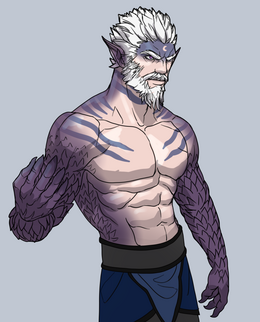
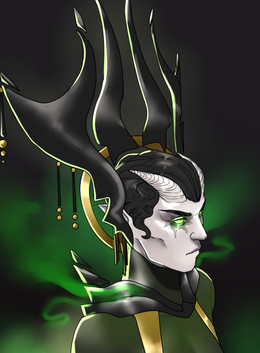
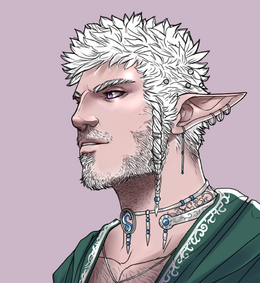
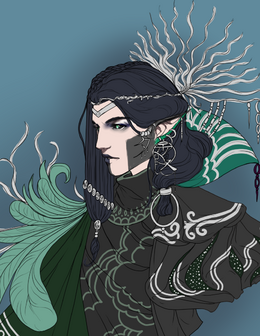
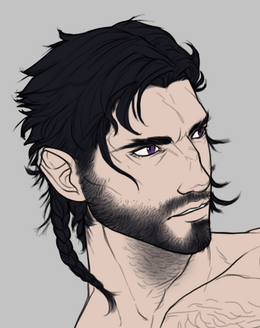
As earlier described, the Isldarrin language, Sulvaley, shares a family with other Nelfin languages. It has diverged somewhat over the centuries the Isldar have spent in Ellador since their departure from the Allorn Empire. Sulvaley is ascribed Arabic phonetics, with glottal stops and harsh consonants not found in most other Nelfin vocabularies.
Example Isldar male coded names: Arfa, Eriannan, Irifa, Ursal, Arqaam, Arslan, Aryaan, Irsaley, Ercaror, Henqaan. Most Isldarrin male names start with vowels, and double As are common.
Example Isldar female coded names: Almeya, Cuadhïra, Erthira, Kharaera, Vyara. They can also be made by modifying male coded names. For example, Erianna, Ursaela, Arslanna, Irsaleya, Ercantha, Henqaena.
Isldar names are not very complicated. In addition to their first name, most have a last name, but some Isldar do not bother. When decades are spent in the field, many soldiers abandon the difficulty of a second word to remember.
Religion
The Isldar are bitterly divided along religious lines. The Life Cult worships Aurora or Regulus from Dragon Worship, while the Death Cult worships Frisit (The Glacial) from Ordial Worship. To learn more about these beings’ beliefs and how to worship them beyond the surface level, reading the linked pages is encouraged. For the Life Isldar, having Aurora or Regulus as a favored Dragon is not a requirement, though the majority do choose those two. Choosing a different Dragon to suit one's own ideology is perfectly acceptable, and even changing favored chosen Dragon is permissible.
Families
Childhood
Isldar children are often communally raised. Their parents might be often away at other holds, at observatory centers, or at war. This means that they have a very open-ended perspective from very early on concerning social bonds, and get into the easy habit of forming new relationships quickly. Physical exercise and drills are encouraged, and while outsiders might describe the whole process as austere, Isldarrin children often leave their young years healthy and with a wide range of experiences both inside their breathtaking holds and outside in the wilderness of Ellador, learning what it takes to survive the frost and keep your bearings.
Adulthood
The Isldarrin concept of adulthood is dominated by civic duty. With how Ellador has been since their arrival, this usually means military duty. All Isldar are brought in for conscription at the age of twenty, and taught a series of standard weapons, traditionally the bow and the spear. Most do not see active duty immediately, because the style of guerilla warfare the Isldar prefer means that very few units are operating at any given time. However, with the outbreak of the civil war within Isldar society and the upheaval of more intense Vampiric and Regalian invasions, the Isldar of recent years have been exposed to an unusual amount of bloodshed. Upon completing a single mandatory tour, Isldar are given the option to leave Ellador, an option which many take: better to adventure out in the world, than to stay as a footman at home.
Romance & Gender Norms
Isldar romance is perhaps one of the most stiff things imaginable: their famous lack of comedy and social wit would make an observer question whether that stiffness is an intentional element they throw in to make things easier. However, on the flipside, it is extremely honest. There are no cat-and-mouse games, veiled declarations of affection, and tree-shade flirting among the Isldar. Intentions are stated openly and honestly, and accepted or declined much the same without contest. The Isldar do not have gender norms: all must learn to fight, all must learn to excel at the same roles in life, and all must do their duty to their country.
Fashion
Isldarrin fashion differs between the Bene Vixit and the Bene Rexit. Both follow the basic rules of Nelfin clothing: robes are in style, long sleeves, and flowing, patterned fabric. The Life Isldar favor generally lighter colors and looser, more practical clothes which keep the roughness of the wilderness off of them. Tough cloaks and leather boots are common, as is anything that keeps them safe, and can double as limited protection in the case of an attack. Practicality is key. The Death Isldar, meanwhile, dress to impress - their priests wear outlandish headdresses, while even the laymen have an impeccable sense of style. Black and dark gothic styles are everywhere, impractically high heels as well, and stunning multicolor makeup that can sometimes take up to an hour to apply. The Bene Rexit do not go anywhere without looking on point.
World View
World View is optional content that helps give Isldar flavor and depth.
- The historical enemies of the Isldar are the Dwarves, the Dorkarth Vampires, Hedryll, and the Regalian Empire. The Dwarves because they aggressed on them upon arriving in Ellador and because the Dwarves are responsible for Asaph’s original death, and the other three because they have been making steady incursions into Isldar territory in the past hundred years.
- Both Life and Death Isldar keep Wyverns as their mounts of choice, and fancy themselves the best riders in Aloria. The outbreak of the Civil War has seen some breathtaking Wyvernback duels between champion Isldar in the frosty clouds of Ellador.
- Life Isldar form life bonds with their Wyverns. They believe that if their Wyvern perishes, the next they acquire is their reincarnation, and go to painstaking lengths to find a new mount that was born the day their previous one died.
- Isldar are excellent choral singers, and also favor the harp. Their music is credited as holding a certain angelic quality seldom seen, and their hymns are traditionally used as the closing act in famous operas and stagehouses around Aloria.
- Isldarrin sports always have a military angle to them. For example, javelin throwing is popular, but only because being good at throwing a javelin during downtime translates to being good at throwing a javelin when in the front lines of a snowstorm skirmish.
- Isldar love symposiums and debates. They are deeply individualistic, and having a platform to make their positions known to one another is seen as cathartic and relaxing. This tendency to debate for fun can create little social faux pas with those who don’t understand.
- Isldar also love hunting. Life Isldar because it is the divine wish of Asaph that her followers should test the limits of her infinite creations, and Death Isldar because Frisit is pleased by the tribute of souls, even ones that do not come from sentient enemies.
- Isldar are famously blunt, and do not have a concept of irony or sarcasm in their culture. This can lead to two things: firstly, statements on their part can be unintentionally comedic, and secondarily, they can miss or ignore implications in things others say.
- Death Isldar decorate their Undead followers lavishly, offering them tribute in gold, fine silks, and embellished armor so that their good appearance can reflect favorably back on them. Matching outfits are considered in vogue.
- The Isldar live in so-called ‘Moon Vaults,’ ice palaces etched into the sides of the mountains and filled with countless bedazzled halls which shine in the moonlight. They are so named because their inner vaults only open to a particular series of keys when the moon is full.
- The (in)famous metal known as ‘Skysteel’ was recently revealed to be an elaborate ploy by the Bene Rexit to lure gullible Ailor into Ellador to kill them and steal their belongings (and souls.)
- The Isldar mostly subsist on fruits and arctic fauna, but their most famous culinary export is a dessert called a moon pie, two pastries with a thick circle of chilled vanilla icing sticking them together.
- Isldar love hiking and difficult terrain. In Regalia, this means that many Isldar take to parkour, something they invite strangers along on frequently just for the experience. Crookback residents frequently complain about the clatter of Isldar feet on their shoddy roofs at nighttime.
- The Isldar are masters of guerilla warfare. They invented it, and benefit from being immune to the cold on a continent which is hilly and consistently below zero degrees. To challenge them on their own terrain is nothing short of foolhardy.
- The Isldar language is suited for spoken poetry, having a reputation for well-paced emotional reflections on the nature of life and the self among their Nelfin cousin races. Quite a few Teledden, even, have taken to the ‘Isldarriyát’ genre of quatrains.
- Death Isldar consider husky, hoarse voices desirable in both speech and music. They surmise among themselves that this preference comes from the harsh syllables naturally present in Deathspeech leaking over into their other languages.
- Death Isldar courtship rituals involve eliminating all other potential suitors, literally. The road to romance is fraught with saber duels under moonlight.
- The Isldar like to play checkers. Not because it is considered mentally challenging, but because the white pieces are a metaphor for the Life Isldar and the black pieces are a metaphor for the Death Isldar: different colors, but the same shape.
- Life Isldar handle Undead by giving them ‘penance periods,’ a window of grace after which they will hunt them and put them down on the spot. In Ellador, some Undead surprisingly accept this fate with grace, but the same cannot be expected in Regalia.
- Isldar liquor is all berry-flavored and very sweet. Cloudberries, blueberries, blackberries. It is drunk in shots and is always a pleasant stomach-warmer in Ellador’s cold temperatures.
Trivia
- Isldar cannot feel cold food. It all tastes perfectly warm to them.
- Ellador hosts the world’s only bi-annual Dart and Backflip Tournament.
- There is a romance novel involving a Maquixtl shieldmaiden and an Isldar huntress.
| ||||||||||||||||||||||
| Accreditation | |||||||||
|---|---|---|---|---|---|---|---|---|---|
|
| ||||||||
